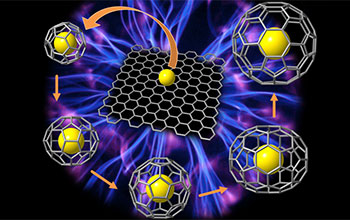Multimedia Gallery
Promising nanomaterial's origin revealed
An artistic representation of the transformation of graphene and a metal into endohedral metallofullerenes in plasma.
More about this image
A study by Florida State University (FSU) scientists is offering new understanding of how an intriguing nanomaterial called metallofullerene is formed.
Part of the carbon family, metallofullerenes are related to what is known as buckyballs, or fullerenes -- hollow, soccer-ball-shaped spherical cages that represent a basic form of carbon. The empty spaces in the fullerenes can trap metal atoms, resulting in metallofullerenes.
"Metallofullerenes are a unique form of molecular nanocarbon," says Paul Dunk, a chemist at FSU and co-author of the published study. "They are potentially useful in a number of biomedical diagnostics, in particular as MRI contrast agents."
Dunk adds, "Under certain conditions, metallofullerenes can have spectacular properties that make them prized as advanced materials for an array of technologies, such as conversion of sunlight into electricity and as possible components of molecular electronics."
Findings from the study could help pave the way for metallofullerene-based applications that range from biomedicine to renewable energy.
To discover how metallofullerenes are synthesized in a lab, the research team relied on the high magnetic field instrumentation available at the Ion Cyclotron Resonance facility at the National High Magnetic Field Laboratory, which is funded by the National Science Foundation (NSF) (under grant DMR 11-57490) and the state of Florida.
To learn more about this research, see the FSU news story Promising nanomaterials origin revealed. (Date image taken: 2015; date originally posted to NSF Multimedia Gallery: Feb. 12, 2016)
Credit: Paul Dunk, Florida State University
Images and other media in the National Science Foundation Multimedia Gallery are available for use in print and electronic material by NSF employees, members of the media, university staff, teachers and the general public. All media in the gallery are intended for personal, educational and nonprofit/non-commercial use only.
Images credited to the National Science Foundation, a federal agency, are in the public domain. The images were created by employees of the United States Government as part of their official duties or prepared by contractors as "works for hire" for NSF. You may freely use NSF-credited images and, at your discretion, credit NSF with a "Courtesy: National Science Foundation" notation.
Additional information about general usage can be found in Conditions.
Also Available:
Download the high-resolution JPG version of the image. (386 KB)
Use your mouse to right-click (Mac users may need to Ctrl-click) the link above and choose the option that will save the file or target to your computer.

